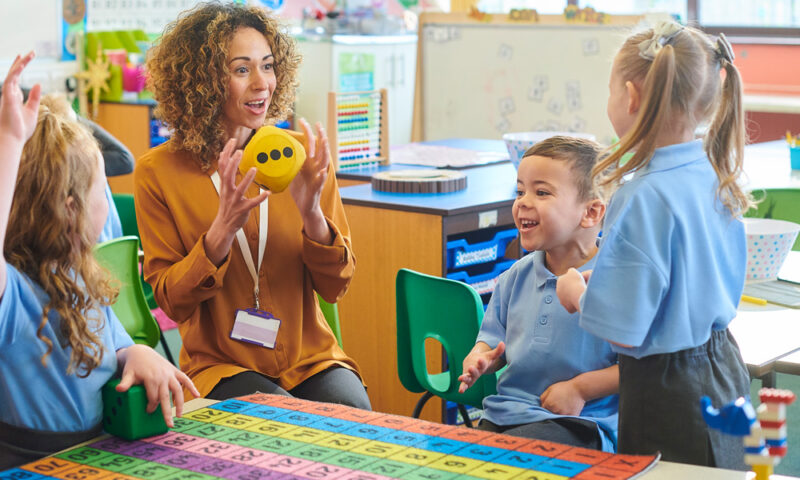Great Ideas
Making the Most of Math Small Groups
When I talk with teachers, I often hear that they don’t have time for or don’t know how to make the most of small-group instruction. I believe that having students work in teacher-facilitated small groups is essential for students to become competent mathematicians. All parts of math instruction are important, but I think the thinking and reasoning that happens in small groups is often where students make breakthroughs, cement their knowledge, and make connections between concepts.
Why Are Math Small Groups Important?
Small groups are where so much of student learning takes place. It’s often the time when students have that wonderful aha moment when a skill or concept they have been struggling with suddenly makes sense. It’s a joy to witness and helps students feel competent and confident. Here are just a few of the benefits of small groups:
- Make learning accessible to every student.
- Ensure all voices are heard.
- Provide multiple entry points to problems.
- Support the use of multiple representations.
- Individualize instruction.
- Encourage rich math discourse.
- Promotes productive struggle.
- Provides a safe space to make mistakes.
- Facilitate deep thinking and reasoning.
- Showcase student strengths.
- Strengthen student collaboration.
- Support productive struggle.
- Build student confidence and agency.
- Supports a love of math.
Grouping Students Purposefully
Despite our best intentions, we often create static groups in school, groups that a student is slotted into and stays in. This can lead to different tracks based on initial assessments that doom students in “lower” groups to lesser mathematics achievement. That’s a problem. It’s an equity issue. It’s a learning issue. As noted above, small groups should provide students with equal access to deep math learning, the time to explore multiple approaches and strategies, the opportunity to learn from classmates, and ultimately a path to math success.
There are different ways to group students, but I believe that small groups should always flexible. The students in a particular group today may not be in that group next week. Flexibility helps students collaborate with different peers, individualizes instruction to meet student needs at the time, and demonstrates that learning is always evolving. Flexible grouping presents every child with the opportunity to engage in rich math content.
The core group is the one you use for day-to-day instruction, perhaps organized by pushing desks together to make four to six big tables. These groups should be heterogeneous, which research shows is essential. You might consider skills, gender, language acquisition, or other attributes as you form these groups. You may decide to keep these core groups for the entire year, or you might change them as I did when I taught sixth grade every marking period which for me meant four times per year.
Heterogeneous groups benefit all students. Students learn from and support each other, are exposed to a greater range of ideas, and engage in more robust math discussions, all of which lead to deeper understanding of math concepts for everyone.
Random grouping is just for a single day or a single activity. I like to form groups of three, since I think in larger groups, it may be too easy for a student to hide. You can group randomly using any method you like. I use playing cards and separate out enough ranks to form groups of three. I put an Ace on one table, a King on another, a Queen on yet another, and so on. And then I shuffle the remaining reduced deck of cards and each student selects a card and goes to the table with the matching rank.
Deliberate, instructional groups cluster students based on a specific math skill or concept. It needs to be normal that all students work with the teacher at some time on different concepts. And we want to be careful about how we refer to these groups, we want to concentrate on what we are learning and not place a value (advanced or basic) on the learning. The important thing to communicate is that students are taking different paths and moving at different speeds but are all ending up in the same place.
Strategies for Making the Most of Small Group Time
1. Teach the routine you’ll use during small-group time. The whole class needs to agree upon small-groups, so students know what this time looks and sounds like and understand group expectations. These norms may mirror those you have established for the whole class or they may be slightly different. Think about noise level, discussion guidelines, group participation expectations, using manipulatives, transitioning to individual or whole-class time, etc.
2. Focus on a single learning target or skill in random (unless the group stays together for the whole day) and instructional groups. If you have multiple learning goals, you may end up doing most of the talking. Small groups are not a time for direct instruction. They are purposely student-centered to provide time for students to explore various approaches and strategies, explain a concept in their own words, justify their thinking, and respectfully challenge classmates’ ideas. And don’t forget to make sure students understand the learning target and how success will be measured.
3. Ensure that everyone participates so each student has an opportunity to share their ideas and the group gets the maximum benefit of learning from each other. Small groups are particularly important for shy students, reluctant learners, and English Learners as the group setting provides them time in a low-stakes setting to translate their ideas into words. Working together helps all students persevere through difficulties as they discover that at times everybody finds math challenging. Finally, when kids learn from (and teach) each other they are empowered as mathematicians.
4. Ask questions that get students thinking and talking. Your instructional goals for the small group lesson will determine what type of questions you ask. But in general, since you want to encourage discussion and help move students toward the learning target, you may ask more open-ended questions that focus on student thinking and the strategies they use to approach the problem. Remember small-group time is all about students doing the thinking and talking. [Read more about purposeful questioning.]
5. Use rich math tasks that promote student reasoning and problem-solving and help students make connections between concepts. If the goal of your small group is to get students thinking deeply about math, rich tasks provide a wealth of learning opportunities. Students will use different approaches, explore new ideas, explain their reasoning, question peers’ solution paths, and delve deeper into the math behind the task. [Read more about rich math tasks.]
6. Provide differentiated materials that meet learners’ where they are. Before you panic thinking that you have to create or find new problems and tasks, you can start with what you have and make modifications. You can use problems from your curriculum and make them easier for students who are struggling or more complex for students who need greater challenge. The important thing is that all students are working on the same task and can still have robust discussion about how to solve the problem. Additionally, this approach demonstrates that all students can do math, their approach may be different and their journey a bit longer, but they all reach the same point in the end.
7. Assess students, and encourage them to self-assess, throughout small-group time to ensure that they are moving toward the learning target. There will be many opportunities for you to gauge how students are doing and pivot to better address student needs. You may uncover a misconception or discover a student strength. You’ll definitely learn more about how to shape your small-group and whole-class instruction going forward.
When students know where they are heading, they can assess their own progress. This helps students direct their own learning, building agency and facilitating transfer to new concepts and situations.
Getting the most out of small groups takes time, and it probably looks a bit different with every class of students. Just know that the time your students spend in small groups helps them achieve grade-level standards, gain a deeper understanding of math concepts, and may even prove that math is fun.




